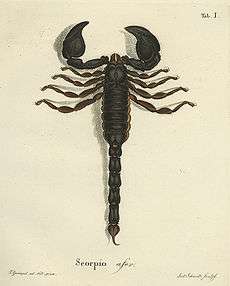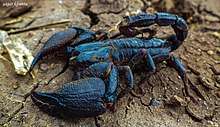Heterometrus
Heterometrus, whose members are also known by the collective vernacular name giant forest scorpions, is a genus of scorpions belonging to the family Scorpionidae. It is distributed widely across tropical and subtropical southeastern Asia, including Cambodia, Laos, Thailand, Vietnam, India, Sri Lanka, Nepal, and China (Tibet).[3][4] It is notable for containing some of the largest living species of scorpions.
| Heterometrus | |
|---|---|
 | |
| Heterometrus indus, historical illustration (as Scorpio afer) from J.F.W. Herbst's Natursystem der ungeflügelten Insekten (1800).[1] | |
| Scientific classification | |
| Kingdom: | |
| Phylum: | |
| Class: | |
| Order: | |
| Family: | |
| Subfamily: | Scorpioninae |
| Genus: | Heterometrus Ehrenberg, 1828 |
| Type species | |
| Buthus (Heterometrus) spinifer Ehrenberg, 1828[2] | |
| Diversity | |
| About 33 species | |
| Synonyms[3] | |
| |
Taxonomy
The genus was introduced by C.G. Ehrenberg (in Hemprich & Ehrenberg, 1828), originally as a subgenus of the genus Buthus.[5] It was elevated to genus rank by F. Karsch in 1879.[2] H.W.C. Couzijn (1978, 1981)[6][7] subdivided the genus into several subgenera, but F. Kovařík (2004)[3] synonymized these subgenera with the nominal genus.
Diversity
The content of this genus may vary, depending on the authority. At least 33 species are known, many of which are quite similar in appearance:[3][7][8]
- Heterometrus barberi (Pocock, 1900)
- Heterometrus liocheles (Kovařík, 2004)
- Heterometrus bengalensis (C.L. Koch, 1841)
- Heterometrus cimrmani (Kovařík, 2004)
- Heterometrus cyaneus (C.L. Koch, 1836)
- Heterometrus flavimanus (Pocock, 1900)
- Heterometrus fulvipes (C.L. Koch, 1837)
- Heterometrus gravimanus (Pocock, 1894)
- Heterometrus indus (DeGeer, 1778)
- Heterometrus kanarensis (Pocock, 1900)
- Heterometrus keralaensis (Tikader & Bastawade, 1983)
- Heterometrus laoticus (Couzijn, 1981)
- Heterometrus latimanus (Pocock, 1894)
- Heterometrus liangi (Zhu & Yang, 2007)
- Heterometrus liophysa (Thorell, 1888)
- Heterometrus liurus (Pocock, 1897)
- Heterometrus longimanus (Herbst, 1800)
- Heterometrus madraspatensis (Pocock, 1900)
- Heterometrus mysorensis (Kovařík, 2004)
- Heterometrus nepalensis (Kovařík, 2004)
- Heterometrus petersii (Thorell, 1876)
- Heterometrus phipsoni (Pocock, 1893)
- Heterometrus rolciki (Kovařík, 2004)
- Heterometrus scaber (Thorell, 1876)
- Heterometrus sejnai Kovařík, 2004
- Heterometrus spinifer (Ehrenberg, 1828)
- Heterometrus swammerdami (Simon, 1872)
- Heterometrus telanganaensis (Javed, Mirza, Tampal & Lourenço, 2010)
- Heterometrus thorellii (Pocock, 1897)
- Heterometrus tibetanus (Lourenço, Qi & Zhu, 2005)
- Heterometrus tristis (Henderson, 1919)
- Heterometrus ubicki (Kovařík, 2004)
- Heterometrus wroughtoni (Pocock, 1899)
- Heterometrus xanthopus (Pocock, 1897)
General characteristics
Members of Heterometrus are generally large-sized scorpions (100–200 mm total length). Coloration is dark in most species, often uniformly brown or black, sometimes with a greenish shine, with brighter-colored telson, walking legs, and/or pedipalp pincers in some species. The scorpions are heavily built with especially powerful and globose pedipalp pionkes, broad mesosomal tergites and a proportionally slender and thin metasoma. The telson is proportionally small and the stinger is often shorter than the vesicle. The cephalothorax and mesosoma are largely devoid of carinae and granulation and the median eyes are situated in a small, lenticular depression on the cephalothorax. Some species are parthenogenic.[3][7]

Toxicity
As in other genera of the Scorpionidae, the symptoms from Heterometrus envenomations are rather mild and no human fatalities are known.[7] The sting causes local pain, inflammation, oedema, swelling, and redness of the skin, lasting for hours to a few days. Plant extracts known in the traditional Thai medicine as natural scorpion venom antidotes are effective as symptomatic treatment of H. laoticus stings.[9] The protein heteroscorpine-1 was found the major component of the venom in H. laoticus.[10]
Habitat for the scorpion
Species of Heterometrus live in vegetated, often forested, humid regions with subtropical to tropical climates. As most scorpions, they are predominantly nocturnal and hide in burrows, below logs, and in leaf litter.
In captivity
Due to their impressive size, low toxicity, and docile behavior, species of Heterometrus are popular pet scorpions. Unlike many other scorpions, they can be kept in pairs or small groups.
References
- Herbst, J.F.W. (1800). Natursystem der ungeflügelten Insekten (in German). Viertes Heft. G. A. Lange. pp. 1–86.
- Karsch, F. (1879). "Skorpionologische Beiträge I.". Mitteilungen des Münchener Entomologischen Vereins (in German). 3: 6–22.
- Kovařík, F. (2004). "A review of the genus Heterometrus Ehrenberg, 1828, with descriptions of seven new species (Scorpiones, Scorpionidae)" (PDF). Euscorpius. 15: 1–60.
- Lourenço, W.O., Qi, J.-X., & Zhu, M.-S. (2005). "Description of two new species of scorpion from China (Tibet) belonging to the genera Mesobuthus Vachon (Buthidae) and Heterometrus Ehrenberg (Scorpionidae)" (PDF). Zootaxa. 985: 1–16.CS1 maint: multiple names: authors list (link)
- Hemprich, F.G.; C.G. Ehrenberg (1828). "Zoologica II. Arachnoidea. Plate I: Buthus; plate II: Androctonus.". Symbolae physicae seu icones et descriptiones animalium evertebratorum sepositis insectis quae ex itinere per Africam borealem et Asiam occidentalem (in Latin). Berlin: Officina Academica, Decas Prima. pp. Plates IX–X.
- Couzijn, H.W.C. (1978). "The method of polythetic analysis applied to a source of taxonomic difficulty: The genus Heterometrus H. & E., 1828 (Scorpionidae)". Symposium Zoological Society London. 42: 327–333.
- Couzijn, H.W.C. (1981). "Revision of the genus Heterometrus Hemprich & Ehrenberg (Scorpionidae, Arachnoidea)" (PDF). Zoologische Verhandelingen. 184: 1–196.
- Rein, J.O. (2010). "Scorpionidae Latreille, 1802". The Scorpion Files. Norges Teknisk-Naturvitenskapelige Universitet. Retrieved April 21, 2010.
- Uawonggul, N., Chaveerach, A., Thammasirirak, S., Arkaravichien, T., Chuachan, C., & Daduang, S. (2006). "Screening of plants acting against Heterometrus laoticus scorpion venom activity on fibroblast cell lysis" (PDF). Journal of Ethnopharmacology. 103 (2): 201–207. doi:10.1016/j.jep.2005.08.003. PMID 16169172. Archived from the original (PDF) on 2011-07-22.CS1 maint: multiple names: authors list (link)
- Uawonggul, N., Thammasirirak, S., Chaveerach, A., Arkaravichien, T., Bunyatratchata, W., Ruangjirachuporn, W., Jearranaiprepame, P., Nakamura, T., Matsuda, M., Kobayashi, M., Hattori, S., & Daduang, S. (2007). "Purification and characterization of Heteroscorpine-1 (HS-1) toxin from Heterometrus laoticus scorpion venom". Toxicon. 49 (1): 19–29. doi:10.1016/j.toxicon.2006.09.003. PMID 17056081.CS1 maint: multiple names: authors list (link)
External links
- Keeping instructions for H. spinifer and H. laoticus. Exotic Pets
- Images and descriptions of various species of Heterometrus. Mes Scorpions